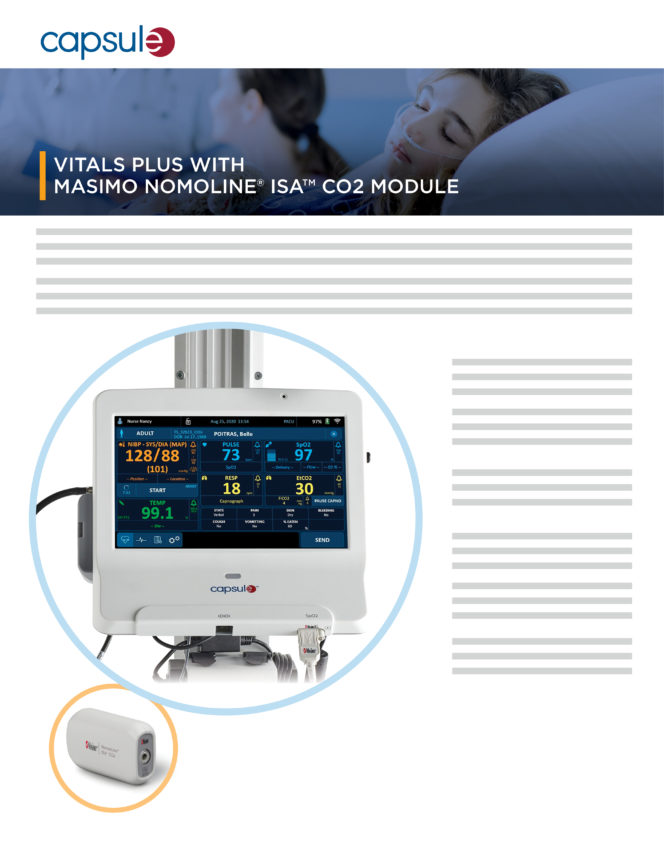Beyond the ICU, this patient monitoring method saves lives and improves outcomes
Colloquially, they are called “never events,” but the National Quality Forum refers to them as “serious reportable events.” They are usually catastrophic, involving the death of the patient, and in some instances, due to healthcare delivery errors and accidents, can result from the undetected decline of the patient. These events are undetected compensation leading to respiratory failure and arrest, and, ultimately, if no interventions are performed, the result is death.
Although never events can occur anywhere in the hospital, patients with pre-existing respiratory illnesses, or those patients who have received procedural sedation or “other anesthetic approaches” involving the “suppression of ventilation and reduced airway protection” can make such patients vulnerable to respiratory failure from “opiate-induced” or “immobility-induced” respiratory depression, pulmonary embolus, or atelectasis.[i] Thus, patients returning from general surgery or procedures to the post-anesthesia care unit (PACU) and Medical-Surgical Units, or those patients who have preexisting respiratory conditions on the General Care Units, can experience respiratory depression and unattended respiratory decline. In a study involving nearly 1,300 patients in the PACU, 13.6% experienced blood oxygen desaturation, 5.8% hypotension, and 5.5% sleep apnea. Such complications, however, may be overlooked without specific monitoring, namely capnography, and patients could decompensate to the point of a never event.
We discussed the use of continuous capnography to monitor pulmonary ventilation in our first post on the limitations of heart rate and SpO2 monitoring alone for opioid-induced respiratory depression. This post will further examine the importance of capnography and the benefits that capnography monitoring can offer for post-operative patients recovering from anesthesia and/or receiving opioid pain relief. Based on the growing evidence supporting the use of capnography more widely throughout the hospital, health systems and ambulatory surgical centers should consider adding this postoperative care monitoring adjunct to its policies and procedures.
PACUs May Be Less Monitored
Surrounded by physicians, nurses and many monitoring devices, patient deaths in the operating room due to respiratory compromise and depression are rare. When the patient is transferred to the PACU and to recovery areas, however, the dynamic changes dramatically. Depending on the patient’s risk profile, pre-existing conditions, duration of anesthetic sedation, etc., the patient’s recovery from sedation and need for postoperative pain medication can have a significant influence on the patient’s ability to metabolize the anesthetic and analgesic drugs, predisposing him or her to postoperative respiratory depression. Excessive sedation has been the “most important predictor of respiratory depression in hospitalized patients” receiving intravenous analgesics.[ii]
In one such case in 2007, 17-year-old Logan Parker was recovering from surgery to correct his sleep apnea. Just minutes after being discharged from the PACU, Logan experienced respiratory failure and later died from opioid-induced hypoxia.
Respiratory issues account for nearly half (43%) of PACU complications, according to one study, but many postoperative patients, like Logan, may receive limited monitoring to alert clinicians of problems. As we discussed in our previous post, monitoring of oxygen saturation and heart rate alone can help prevent an adverse event, but they are lagging indicators. Capnography is an instantaneous indicator of respiratory status as it measures ventilation adequacy, which helps clinicians identify and prevent complications from respiratory depression.
One study of 194 postoperative pediatric patients in the PACU found capnography detected hypoventilation or apnea in 45.5% of patients. Researchers concluded that routine monitoring with capnography could improve clinician recognition and protect patients; this determination was echoed by the authors in a similar study the following year.
Simplifying Capnography
Capnography is not a common monitoring technique in lower-acuity and lower-risk postoperative patients. Capnography is an essential monitoring adjunct, which is employed during intubated respiratory monitoring, in patients who experience respiratory distress in the field, and in patients who have experienced cardiac arrest. Yet, nursing staff in general and other non-critical care medical-surgical units may have received less training in the use of capnography or in reading capnograms, which are the end-tidal carbon dioxide waveform plotted either against time or volume during a respiratory cycle. This challenge, of course, can be overcome through in-servicing and training.
In the last blog post, we described how reviewing capnograms would be another of many tasks for nurses, including in the PACU, who must also monitor multiple patients at the same time. When capnography and data from multiple other monitoring devices are captured by an integrated platform, such as Vitals Plus from Capsule Technologies, nurses can identify early signs of postoperative respiratory depression through changes in the capnogram that are due to complications from anesthesia or opioids, and initiate life-saving interventions, much like would happen in an ICU or other higher acuity environment.
Vitals Plus enables continuous monitoring and can work in concert with remote surveillance, but without adding staff or significantly changing nursing workflows. This is possible because Vitals Plus feeds physiologic data to Capsule’s Medical Device Information Platform and the Capsule Surveillance workstation. The smart algorithms of Capsule Surveillance aggregate these vital signs and other data. If a clinically actionable event is detected, the platform issues an alert notification to members of the patient’s care team at workstation, bedside or through mobile. Since clinicians understand these alerts are based on an analysis of data from multiple devices, they recognize that a more urgent response is necessary and can arrive at the bedside prepared, thanks to the intelligence delivered at the workstation.
Small Change, Massive Benefits
When capnography can help hospitals protect patient safety and can often be easily integrated into workflows, new policies and procedures should be considered to require the monitoring technique across a wider range of postoperative patients. Although clinical workflow changes are never easy to implement, this small additional step is far outweighed by the massive benefit of preventing patient harm and saving lives.
About the authors
John Zaleski, PhD, NREMT, is the Head of Clinical Informatics at Capsule Technologies.
Greg Eckstein is the Director of Product Management for Patient Monitoring at Capsule Technologies.
Learn more about adding capnography to your postoperative workflows with Vitals Plus.
Download